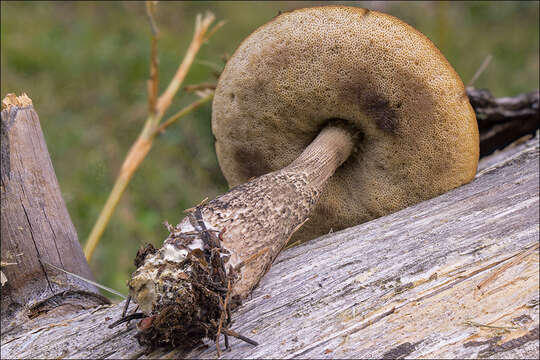Leccinellum-pseudoscabrum_6

Kuvaus:
Leccinellum pseudoscabrum (Kallenb.) Mikk, syn.: Boletus brunneobadius J. Blum, Boletus carpini (R. Schulz) A. Pearson, Krombholziella brunneobadia (J. Blum) Bon, Leccinellum carpini (R. Schulz) Bresinsky & M.Binder, Leccinum carpini (R. Schulz) M.M. Moser ex D.A. Reid, Leccinum pseudoscabrum (Kallenb.) utara.Family: BoletaceaeEN: Hazel Bolete, DE: Hainbuchenrhrling, Hainbuchen-RaufurhrlingSlo.: gabrov dedDat.: Aug. 12. 2021Lat.: 46.36131 Long.: 13.70157Code: Bot_1395/2021_DSC4091Habitat: grassland, former pasture, 15 m away of mixed forest edge; slightly inclined mountain slope, south-east aspect; calcareous, colluvial, skeletal, water permeable ground; dry and sunny place; exposed to direct rain; average precipitations ~ 3.000 mm/year, average temperature 7-9 deg C, elevation 625 m (2.050 feet), alpine phytogeographical region.Substratum: soil.Place: Lower Trenta valley, between villages Soa and Trenta, Na Melu place, on the upper part of a former pasture next to Trenta 2b cottage, East Julian Alps, Posoje, Slovenia EC Comments: Leccinellum pseudoscabrum (until 2017 named Leccinum pseudoscabrum) is a rather common mushroom in Slovenia. It can be found under hornbeam trees (genus Carpinus) or more rarely under hazel (Corylus avellana) in contrast to very similar Leccinum scabrum, which grows under birches (genus Betula). For both species, there are very few exceptions known from these tight mycorrhizal relations. This find is interesting in respect to mycorrhiza. There are no Carpinus or Betula trees known as far as a few km away from this find. The closest single Corylus avellana in the vicinity grows 17 m away within the forest edge. It has poorly developed canopy, is about 4 m tall with three - four trunks of 5-7 cm in diameter. It seems impossible that its root system would reach the site of the find. The forest edge near the site is composed of several large Ostrya carpinifolia (15 m away), several large Fagus sylvatica trees (22+ m away), a single Fraxinus excelsior (18 m away, trunk diameter 15 cm) and several small Picea abies. All these trees appear much too far for mycorrhiza with this find. Closer to the find are: a large Picea abies (6.5 m away, trunk diameter 60 cm), a small Frangula alnus = Rhamnus frangula (about 5 m away and 3 m tall, trunk diameter about 10 cm), a small Fraxinus ornus (also about 5 m away, 7 m tall, trunk diameter 15 cm) and a small Fagus sylvatica (about 8 m away, trunk diameter 17 cm, canopy diameter about 3 m). Picea abies is out of consideration regarding mycorrhiza. Neither Frangula alnus nor Fraxinus ornus appear in the literature (accessible to me) as possible mycorrhizal partner of Leccinellum pseudoscabrum or Leccinum scabrum. The root system of the small Fagus sylvatica apparently does not reach the spot. So, what is the mycorrhizal partner in this case remains open.Another strange thing is that the ground on which the fungus was found is dry, highly water permeable, colluvial and skeletal. That is in strong opposition to fresh, moister, usually clayey ground typical for Leccinellum pseudoscabrum. Also, violet tint of blackening after bruising or cutting the mushroom, described in several sources, was not present. Bruising was directly to blackish with no other color tints. May be this determination is wrong? If so, I have no clue, what else can this find be. All other observed traits correspond to Leccinellum pseudoscabrum very well. Growing solitary. Pileus diameter 6.5 cm, tubes up to 1.8 cm long; stem length 10.2 cm, diameter at the base 1.7 cm; taste mild, mushroomy, smell almost none; SP faint, almost invisible, possibly whitish-brown? Spores smooth. Dimensions: (15.1) 16.7 - 18.4 (19.6) (4.8) 5 - 5.6 (5.9) m; Q = (2.8) 3.1 - 3.48 (3.5); N = 30; Me = 17.4 5.3 m; Qe = 3.3. Olympus CH20, NEA 100x/1.25, magnification 1.000 x, oil (spores); in water, fresh material. AmScope MA500 digital camera.Ref.: (1) Personal communications: Leg. MSc. Jernej Trnkoczy; det. Mr. Bojan Rot, www. gobenabovskem.si (2) J. Breitenbach, F. Kraenzlin, Eds., Fungi of Switzerland, Vol.3. Verlag Mykologia (1991), p 70. (3) G.J. Krieglsteiner (Hrsg.), Die Grosspilze Baden-Wrttembergs, Band 2., Ulmer (2000), p 275.(4) R. Phillips, Mushrooms, Macmillan (2006), p 291.(5) T. Lsse, J.H. Petersen, Fungi of temperate Europe, Vol. 1., Princeton University Press (2019), p 767. (x) L. Hagar, Ottova Encyklopedia Hb, Ottova Nakladatelstvi, Praha (2015) (in Slovakian), p 548.(7) S. Buczacki, Collins Fungi Guide, Collins (2012), p 410. (8) M. Bon, Parey's Buch der Pilze, Kosmos (2005), p 40.
Mukana seuraavilla sivuilla:
- Life
- Cellular
- Eukaryota (aitotumaiset)
- Opisthokonta
- Nucletmycea
- Fungi
- Dikarya
- Basidiomycota (Kantasienet)
- Agaricomycetes (Avokantaiset)
- Boletales
- Boletaceae (Tatit)
- Leccinellum
- Leccinellum pseudoscabrum (pähkinäntatti)
Tämä kuva ei ole esillä missään kokoelmassa.
Lähdetiedot
- lisenssi
- cc-by-nc-sa
- tekijänoikeus
- Amadej Trnkoczy
- valokuvaaja
- Amadej Trnkoczy
- alkuperäinen
- alkuperäinen mediatiedosto
- käy lähteessä
- kumppanisivusto
- Flickr Group
- ID


